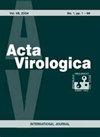慢性乙型肝炎患者多种推测的新型乙型肝炎病毒剪接DNA的分子特征
IF 0.8
4区 医学
Q4 VIROLOGY
引用次数: 0
摘要
剪接乙型肝炎病毒(HBV) RNA已被报道影响病毒生命周期和肝脏疾病的进展。多达30%的HBV RNA在感染细胞中被剪接,其中一些可以逆转录为剪接的DNA。到目前为止,只有一小部分剪接DNA被确定,大多数需要进一步研究。本研究旨在从慢性乙型肝炎患者的血清中鉴定剪接DNA的类型。从血清中分离HBV DNA,用PCR扩增全长DNA和剪接DNA。扩增的PCR产物随后进行亚克隆,并使用桑格序列分析进行测序。结果,鉴定出19种剪接DNA,其中11种被认为是假定的新剪接DNA。这些剪接的DNA通过不同的剪接供体位点和剪接受体位点进行双剪接。除了经常检测到的HBV SP1、SP2和SP4外,我们还在血清中发现了11种推测的新型剪接DNA。这些发现表明HBV RNA剪接在病毒生命周期中的复杂性。本文章由计算机程序翻译,如有差异,请以英文原文为准。
Molecular characterization of multiple putative novel hepatitis B virus spliced DNA from a chronic hepatitis B patient
Spliced hepatitis B virus (HBV) RNA has been reported to affect the viral life cycle and progression of liver disease. As much as 30% of HBV RNA are spliced in infected cells, and some can be reverse transcribed to spliced DNA. To date, only a small number of spliced DNA have been identified and the majority require further investigation. This study aimed to identify the types of spliced DNA from the sera of a chronic hepatitis B patient. HBV DNA was isolated from the serum, and both full-length and spliced DNA were amplified by PCR. The amplified PCR products were then subcloned and sequenced using a Sanger sequence analysis. As a result, 19 types of spliced DNA were identified, 11 of which were assumed to be putative novel spliced DNA. These spliced DNA were doubly spliced with varied splice donor sites and splice acceptor sites. In addition to the frequently detected HBV SP1, SP2, and SP4, we also identified 11 putative novel spliced DNA in the serum. These findings indicate the complexity of HBV RNA splicing during viral life cycle.
求助全文
通过发布文献求助,成功后即可免费获取论文全文。
去求助
来源期刊

Acta virologica
医学-病毒学
CiteScore
3.10
自引率
11.80%
发文量
43
审稿时长
>12 weeks
期刊介绍:
Acta virologica is an international journal of predominantly molecular and cellular virology. Acta virologica aims to publish papers reporting original results of fundamental and applied research mainly on human, animal and plant viruses at cellular and molecular level. As a matter of tradition, also rickettsiae are included. Areas of interest are virus structure and morphology, molecular biology of virus-cell interactions, molecular genetics of viruses, pathogenesis of viral diseases, viral immunology, vaccines, antiviral drugs and viral diagnostics.
 求助内容:
求助内容: 应助结果提醒方式:
应助结果提醒方式:


